- Abstract
- Employment rate in the agricultural sector for women aged 15-64 (percentage of working-age female employed population)
- Employment rate in the agricultural sector for women aged 15-64 (percentage of working-age female employment in the labour force) (Worldwide)
- Employment rate in the agricultural sector for women aged 15-64 (percentage of working-age female employment in the labour force) (World, latest year)
- Employment rate in the agricultural sector for women aged 15-64 (percentage of working-age female employment in the labour force) (region, latest year)
- Reference
Abstract
Employment rate data show that Rwanda’s 56.5% employment rate in the agricultural sector highlights an important feature of the female labour market. Generally, agriculture is the main employment sector in developing countries, with a particularly high proportion of women employed there. Rwanda has a high rate of female employment as agriculture is central to its livelihood. In contrast, developed countries have low employment rates in the agricultural sector and are increasingly diversifying their economies. Historically, employment rates in the agricultural sector have been high in developing countries, but as economies develop and there is a shift to the industrial and service sectors, employment rates in the agricultural sector have tended to decline. Data from Rwanda shows that agriculture continues to play a key role in women’s employment, highlighting the high dependency on agriculture.
Employment rate in the agricultural sector for women aged 15-64 (percentage of working-age female employed population)
Looking at data from 1983 to 2021, employment rates in the agricultural sector for women aged 15-64 in Rwanda show notable fluctuations. In 2000, the rate was high at 92.1%, indicating that agriculture was the core of the economy and that women were the main workforce. However, in 2021, this has decreased to 61.3%. This shift reflects the changing structure of Rwanda’s economy. The background to this is the decline in dependence on agriculture and the ongoing development of industry and the service sector. In general, employment rates in the agricultural sector tend to be high in developing countries, but as the economy develops, there is a shift from agriculture to other industries and employment rates decline. Rwanda is no exception, where the proportion of women working in the agricultural sector is declining as the economy diversifies and urbanizes. This trend reflects the increase in non-farm employment opportunities that accompany economic development, and employment in the agricultural sector is likely to continue to decline in the future.
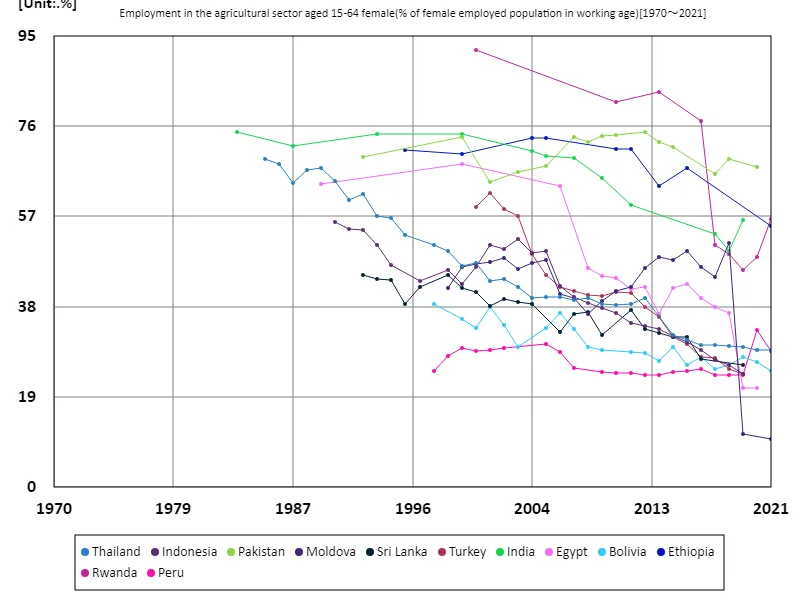

The maximum is 92.1%[2000] of Rwanda, and the current value is about 61.3%
Employment rate in the agricultural sector for women aged 15-64 (percentage of working-age female employment in the labour force) (Worldwide)
Based on data from 1983 to 2021, the employment rate in the agricultural sector for women aged 15-64 in Rwanda has undergone notable changes. In 2000, the employment rate was high at 92.1%, indicating that agriculture was the main pillar of the economy and that women were the main labor force. However, in 2021, that percentage dropped to 61.3%. This shift reflects the changing structure of Rwanda’s economy. In countries with high agricultural employment, agriculture typically plays a central role in the economy and women contribute the majority of the workforce. However, as economies develop and industries diversify, employment rates in the agricultural sector tend to decline. In Rwanda, this trend is clearly evident. As non-agricultural sectors, particularly services and industry, grow, employment opportunities in the agricultural sector are declining, as is the employment rate of women in the agricultural sector. These changes reflect structural changes in the economy, such as more efficient and productive agriculture or increasing urbanization. The case of Rwanda illustrates the changing role of the agriculture sector as an example of economic growth and changing employment structures in developing countries.
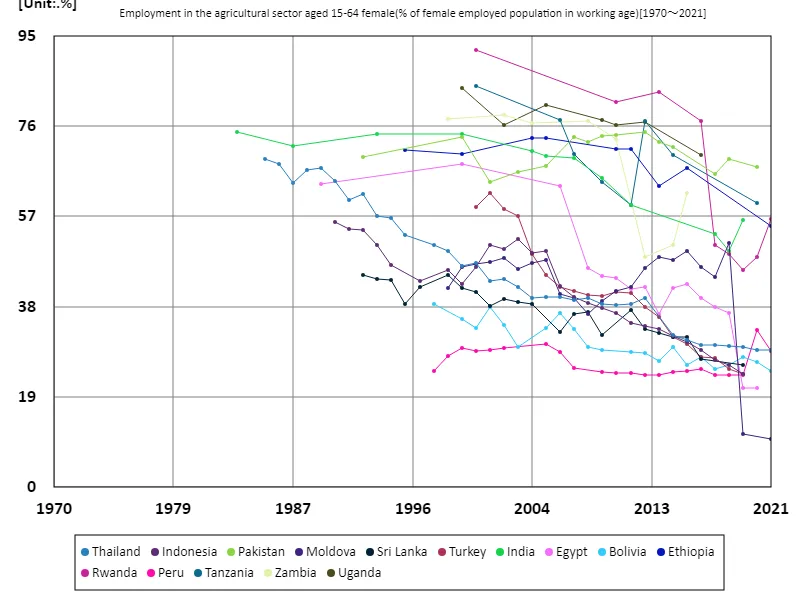

The maximum is 92.1%[2000] of Rwanda, and the current value is about 61.3%
Employment rate in the agricultural sector for women aged 15-64 (percentage of working-age female employment in the labour force) (World, latest year)
Based on 2021 data, Rwanda has the highest employment rate in the agriculture sector for women aged 15-64 at 56.5%, compared to an overall average of 19.6% and a total of 275%. These data show regional variations in women’s employment in the agricultural sector and changes with economic development. In countries with high agricultural employment rates, such as Rwanda, agriculture is at the heart of the economy and women in particular are the main workers. In developing countries where agriculture is important, it is common for many women to be employed in the agricultural sector. Rwanda’s high rate of 56.5% reflects women’s reliance on agriculture. In contrast, in developed countries and countries with diversified economies, employment rates in the agricultural sector are lower and women tend to work in more diverse industries. The average of 19.6% indicates that the agricultural sector accounts for a low proportion of total employment and that the economy is more diversified. The ”total 275%” figure may be the result of adding up figures from multiple countries due to data aggregation and reporting methodology, and may not make sense as a simple sum of the percentages from each individual country. This highlights global differences in agricultural employment and the tendency for agricultural employment rates to decline with economic development.
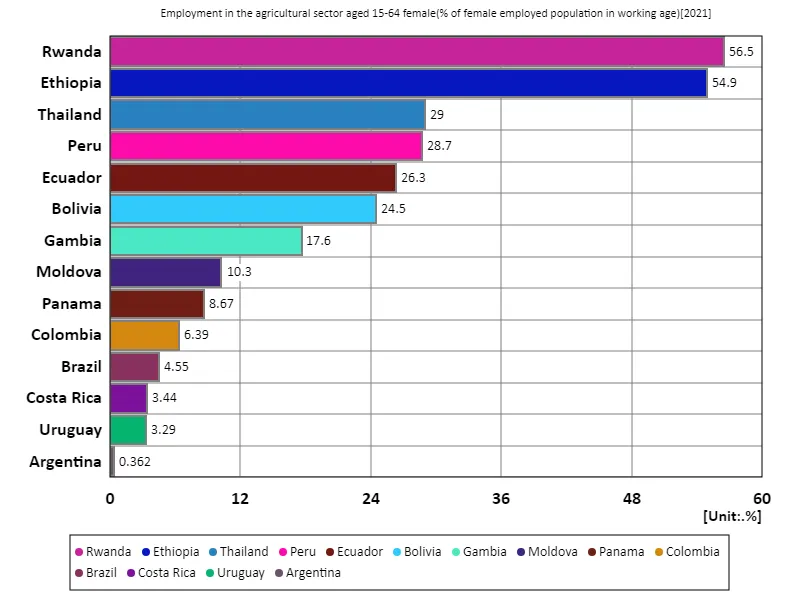

The maximum is 56.5% of Rwanda, the average is 19.6%, and the total is 275%
Employment rate in the agricultural sector for women aged 15-64 (percentage of working-age female employment in the labour force) (region, latest year)
For 2008, the Central African Republic had the highest public sector employment rate for women aged 15-64 in agriculture at 68.3%, while the overall average and total were also 68.3%. The data show the importance of the agricultural sector and regional variations in women’s employment in the public sector. The Central African Republic’s high employment rate reflects agriculture being the main economic activity and women being the main labour force. Agriculture is the basis of livelihood in the country, and many women are employed in agriculture-related jobs in the public sector. The overall average and total figure of 68.3% also suggests that agriculture’s share of public sector employment for women is concentrated in certain regions. This trend is common in developing countries. This is because the agriculture sector plays a central role in the economy and there are many agriculture-related jobs in the public sector. As economic development progresses, employment in the agricultural sector tends to decline, but the 2008 data reveal regional characteristics at that particular time.
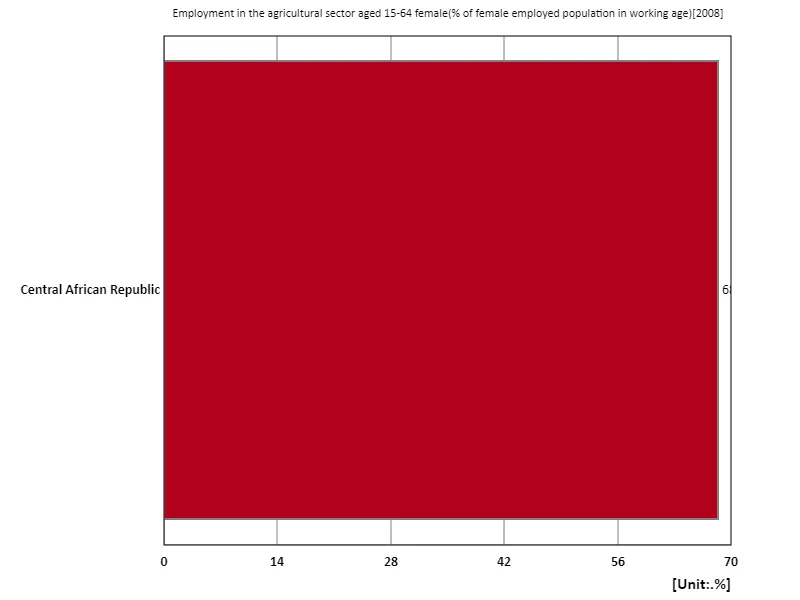

The maximum is 68.3% of Central African Republic, the average is 68.3%, and the total is 68.3%
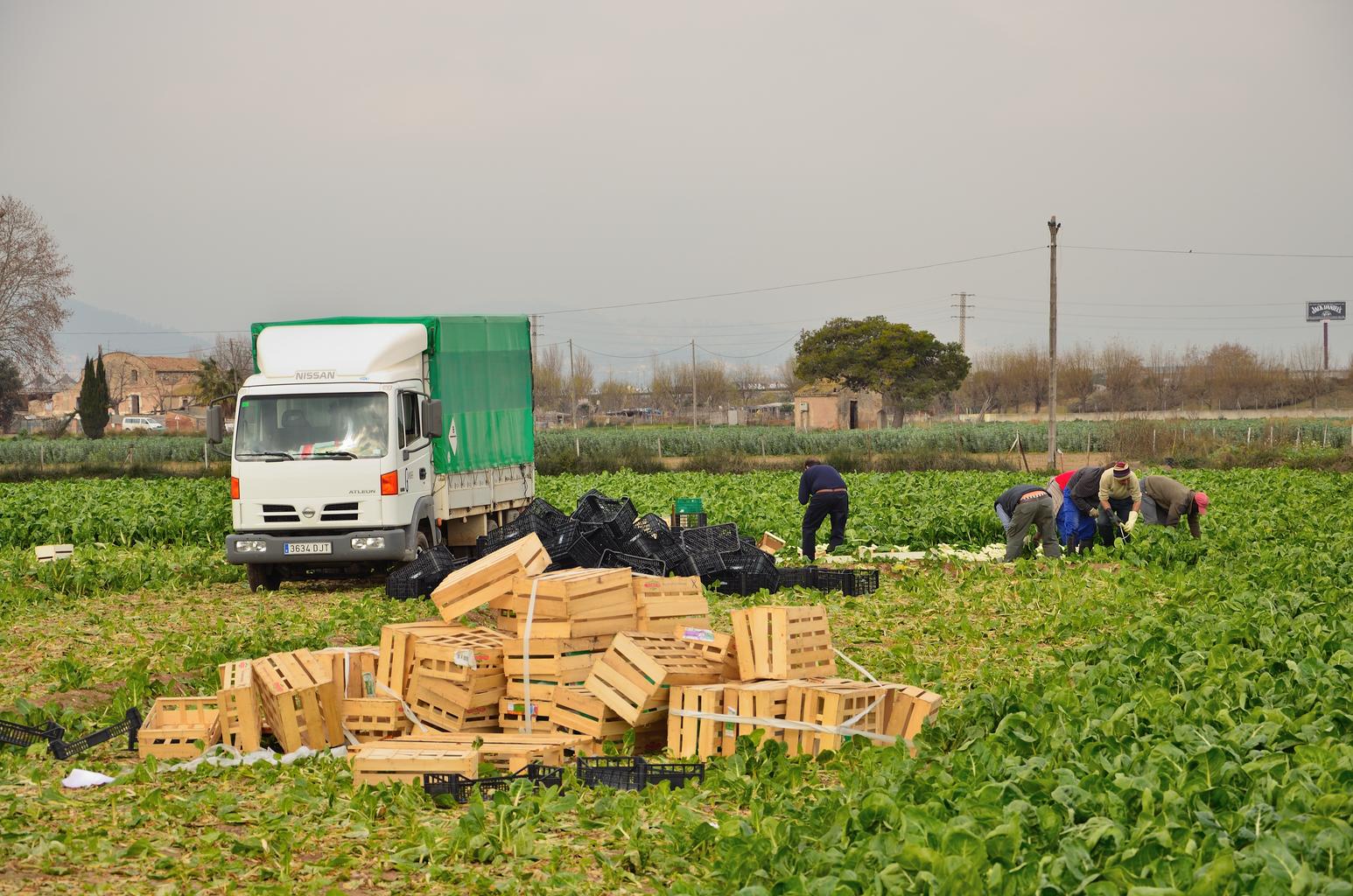


Comments